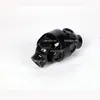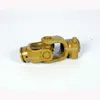When it comes to power transmission in agricultural, industrial, and automotive applications, PTO universal joints are indispensable components. These devices facilitate the transfer of rotational power between shafts that are not aligned, ensuring smooth and efficient operation. In this comprehensive guide, we delve into the details of PTO universal joints, covering their specifications, benefits, and common questions, all presented in a professional manner with lists and tables for clarity.
PTO universal joints, short for Power Take-Off universal joints, are mechanical joints that allow for the transmission of torque and rotation between shafts that are at an angle to each other. They are commonly used in equipment such as tractors, combines, and other machinery where a power source needs to drive an accessory.
To help you understand the technical aspects, here is a detailed list of common parameters for PTO universal joints:
For a quick comparison, refer to the table below showcasing different models:
| Model Number | Bore Diameter (inches) | Max Torque (Nm) | Max Angle (degrees) | Weight (kg) |
|---|---|---|---|---|
| PTO-UJ-100 | 1.0 | 150 | 30 | 2.5 |
| PTO-UJ-200 | 1.5 | 500 | 40 | 4.0 |
| PTO-UJ-300 | 2.0 | 1000 | 45 | 7.5 |
| PTO-UJ-400 | 2.5 | 2000 | 45 | 10.0 |
Investing in reliable PTO universal joints offers numerous advantages, including enhanced efficiency, reduced downtime, and longer equipment life. They are engineered to withstand harsh conditions, providing consistent performance in demanding environments.
Here are some common questions and detailed answers to help users make informed decisions:
What is the typical lifespan of a PTO universal joint?
The lifespan varies based on usage and maintenance, but with proper lubrication and alignment, it can last over 5,000 hours of operation. Regular inspections are recommended to detect wear early.
How do I know if my PTO universal joint needs replacement?
Signs include unusual noises (e.g., clunking or grinding), vibration during operation, visible wear or rust on the joint, or decreased power transmission efficiency. Immediate replacement is advised to prevent further damage.
Can PTO universal joints be used in high-speed applications?
Yes, but it depends on the model's speed rating. Always check the manufacturer's specifications; for speeds above 1000 RPM, specialized high-speed joints are available to ensure safety and performance.
What maintenance is required for PTO universal joints?
Regular greasing every 50 hours of use is crucial to reduce friction and wear. Also, inspect for misalignment and damage periodically. Sealed models may require less frequent maintenance.
Are there different types of PTO universal joints?
Yes, common types include single joint, double joint, and constant velocity joints. The choice depends on the application's angle and torque requirements; double joints are often used for higher angles.
How do I select the right size PTO universal joint for my equipment?
Consider the shaft diameter, torque capacity, operating angle, and speed. Refer to the equipment manual or consult with a supplier to match the joint to your specific needs, using the parameter table above as a guide.
Can PTO universal joints handle misalignment over time?
They are designed to accommodate misalignment, but excessive or prolonged misalignment can lead to premature wear. Ensure proper installation and alignment during setup to maximize longevity.
What materials are best for corrosive environments?
Stainless steel or coated alloys are recommended for applications exposed to moisture or chemicals, as they offer better corrosion resistance compared to standard steel.
Is it possible to repair a damaged PTO universal joint?
In some cases, yes, by replacing worn parts like bearings or cross kits. However, for severe damage, full replacement is often more cost-effective and safer to maintain performance standards.
Do PTO universal joints come with warranties?
Many manufacturers offer warranties ranging from 1 to 3 years, covering defects in materials and workmanship. Always check the warranty terms before purchase.




